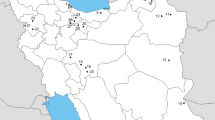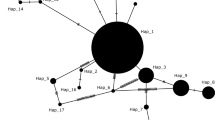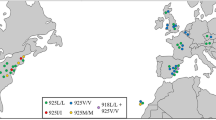Abstract
Varroa destructor is the most common ectoparasite of the Western honey bee (Apis mellifera L.) worldwide and poses a serious threat to bee health. Synthetic acaricides, particularly pyrethroids, are frequently used to control Varroa mites. However, long-term and repeated use of synthetic pyrethroids has led to the development of resistance. In this study, we report on the presence of resistance mutations in the voltage-gated sodium channel in V. destructor populations from Turkish beekeeping areas. Two resistance mutations, L925V and L925I, that were previously associated with pyrethroid resistance, were found in more than 75% of the populations. A general correlation between the presence of mutations and the history of acaricide usage was observed for the sampled hives. In addition, we show there is only a low genetic distance among the sampled V. destructor populations, based on the analysis of three mitochondrial genes: cytochrome b (cytb), ATP synthase subunit 6 (atp6), and cytochrome c oxidase subunit III (cox3). Revealing the presence and geographical distribution of pyrethroid resistance mutations in V. destructor populations from Turkish apiaries will contribute to create more effective mite management programmes.



Similar content being viewed by others
Data availability
All relevant data are within the manuscript.
References
Anderson DL, Trueman JWH (2000) Varroa jacobsoni (Acari: Varroidae) is more than one species. Exp Appl Acarol 24(3):165–189
Alissandrakis E, Ilias A, Tsagkarakou A (2017) Pyrethroid target site resistance in Greek populations of the honey bee parasite Varroa destructor (Acari: Varroidae). J Apic Res 56(5):625–630
Ayan A, Aldemir OS (2018) Genetic characterization of Varroa destructor (Family: Varroidae) prevalent in honeybees (Apis mellifera) in the province of Aydin in Turkey. MAKÜ Sag Bil Enst Derg 6(1):26–32
Ayan A, Aldemir OS, Selamoğlu Z (2017) Analysis of COI gene region of Varroa destructor in honey bees (Apis mellifera) in province of Siirt. TJVR 1(1):20–23
Blacquière T, Altreuther G, Krieger KJ (2017) Evaluation of the efficacy and safety of flumethrin 275 mg bee-hive strips (PolyVar Yellow®) against Varroa destructor in naturally infested honey bee colonies in a controlled study. Parasitol Res 116(1):109–122
Bogdanov S (2006) Contaminants of bee products. Apidologie 37(1):1–18
Çakmak I, Sevençakmak S (2016) Beekeeping and recent colony losses in Turkey. Uludag Bee J 16(1):31–48
Çakmak I, Aydin L, Gulegen E, Wells H (2003) Varroa (Varroa destructor) and tracheal mite (Acarapis woodi) incidence in the Republic of Turkey. J Apic Res 42(4):57–60
Dietemann V, Beaurepaire A, Page P, Yañez O, Buawangpong N, Chantawannakul P, Neumann P (2019) Population genetics of ectoparasitic mites Varroa spp. in Eastern and Western honey bees. Parasitology 146(11):1429–1439
Dong K, Du Y, Rinkevich F, Nomura Y, Xu P, Wang L, Silver K, Zhorov BS (2014) Molecular biology of insect sodium channels and pyrethroid resistance. Insect Biochem Mol Biol 50:1–17
FAOSTAT (2021) Livestock primary production. http://www.fao.org/faostat/en/#data/QL. Accessed 15 Jan 2021
Farjamfar M, Saboori A, González-Cabrera J, Rodríguez CSH (2018) Genetic variability and pyrethroid susceptibility of the parasitic honey bee mite Varroa destructor (Acari: Varroidae) in Iran. Exp Appl Acarol 76(1):139–148
Feyereisen R, Dermauw W, Van Leeuwen T (2015) Genotype to phenotype, the molecular and physiological dimensions of resistance in arthropods. Pestic Biochem Physiol 121:61–77
Gajic B, Radulovic Z, Stevanovic J, Kulisic Z, Vucicevic M, Simeunovic P, Stanimirovic Z (2013) Variability of the honey bee mite Varroa destructor in Serbia, based on mtDNA analysis. Exp Appl Acarol 61(1):97–105
González-Cabrera J, Davies TE, Field LM, Kennedy PJ, Williamson MS (2013) An amino acid substitution (L925V) associated with resistance to pyrethroids in Varroa destructor. PLoS One 8(12):e82941
González-Cabrera J, Rodriguez-Vargas S, Davies TE, Field LM, Schmehl D, Ellis JD, Krieger K, Williamson MS (2016) Novel mutations in the voltage-gated sodium channel of pyrethroid-resistant Varroa destructor populations from the Southeastern USA. PLoS One 11(5):e0155332
González-Cabrera J, Bumann H, Rodríguez-Vargas S, Kennedy PJ, Krieger K, Altreuther G, Hertel A, Hertlein G, Nauen R, Williamson MS (2018) A single mutation is driving resistance to pyrethroids in European populations of the parasitic mite, Varroa destructor. J Pest Sci 91(3):1137–1144
Gregorc A, Knight PR, Adamczyk J (2017) Powdered sugar shake to monitor and oxalic acid treatments to control varroa mites (Varroa destructor Anderson and Trueman) in honey bee (Apis mellifera) colonies. J Apic Res 56(1):71–75
Hall TA (1999) BioEdit: a user-friendly biological sequence alignment editor and analysis program for Windows 95/98/NT. Nucleic Acids Symp Ser 41:95–98
Hernández-Rodríguez CS, Marín Ó, Calatayud F, Mahiques MJ, Mompó A, Segura I, Simó E, González-Cabrera J (2021) Large-scale monitoring of resistance to coumaphos, amitraz, and pyrethroids in Varroa destructor. Insects 12(1):27
Higes M, Martín-Hernández R, Hernández-Rodríguez CS, González-Cabrera J (2020) Assessing the resistance to acaricides in Varroa destructor from several Spanish locations. Parasitol Res 119(11):3595–3601
Hillesheim E, Ritter W, Bassand D (1996) First data on resistance mechanisms of Varroa jacobsoni (Oud.) against tau-fluvalinate. Exp Appl Acarol 20(5):283–296
Hubert J, Nesvorna M, Kamler M, Kopecky J, Tyl J, Titera D, Stara J (2014) Point mutations in the sodium channel gene conferring tau-fluvalinate resistance in Varroa destructor. Pest Manag Sci 70(6):889–894
İnak E, Alpkent YN, Çobanoğlu S, Dermauw W, Van Leeuwen T (2019) Resistance incidence and presence of resistance mutations in populations of Tetranychus urticae from vegetable crops in Turkey. Exp Appl Acarol 78(3):343–360
Johnson RM, Huang ZY, Berenbaum MR (2010) Role of detoxification in Varroa destructor (Acari: Varroidae) tolerance of the miticide tau-fluvalinate. Int J Acarol 36(1):1–6
Khambay B, Jewess P (2005) Pyrethroids. In: Iatrou K, Gilbert LI, Gill SS (eds) Comprehensive molecular insect science, vol 6. Elsevier, Oxford, pp 1–29
Katoh K, Rozewicki J, Yamada KD (2019) MAFFT online service: multiple sequence alignment, interactive sequence choice and visualization. Brief Bioinform 20(4):1160–1166
Kumar S, Stecher G, Li M, Knyaz C, Tamura K (2018) MEGA X: molecular evolutionary genetics analysis across computing platforms. Mol Biol Evol 35(6):1547–1549
Le Conte Y, Ellis M, Ritter W (2010) Varroa mites and honey bee health: can Varroa explain part of the colony losses? Apidologie 41(3):353–363
Liu Z, Tan J, Huang ZY, Dong K (2006) Effect of a fluvalinate-resistance-associated sodium channel mutation from varroa mites on cockroach sodium channel sensitivity to fluvalinate, a pyrethroid insecticide. Insect Biochem Mol Biol 36(11):885–889
Martin SJ (2004) Acaricide (pyrethroid) resistance in Varroa destructor. Bee World 85(4):67–69
McMenamin AJ, Genersch E (2015) Honey bee colony losses and associated viruses. Curr Opin Insect Sci 8:121–129
Mendoza Y, Gramajo E, Invernizzi C, Tomasco IH (2020) Mitochondrial haplotype analyses of the mite Varroa destructor (Acari: Varroidae) collected from honeybees Apis mellifera (Hymenoptera, Apidae) in Uruguay. Syst Appl Acarol 25(8):1526–1529
Millán-Leiva A, Hernández-Rodríguez CS, González-Cabrera J (2018) New PCR–RFLP diagnostics methodology for detecting Varroa destructor resistant to synthetic pyrethroids. J Pest Sci 91(3):937–941
Millán-Leiva A, Marín Ó, Christmon K, VanEngelsdorp D, González-Cabrera J (2021a) Mutations associated with pyrethroid resistance in Varroa mites, a parasite of honey bees, are widespread across the USA. Pest Manag Sci. https://doi.org/10.1002/ps.6366
Millán-Leiva A, Marín Ó, De la Rúa P, Muñoz I, Tsagkarakou A, Eversol H, Christmon K, Van Engelsdorp D, González-Cabrera J (2021b) Mutations associated with pyrethroid resistance in the honey bee parasite Varroa destructor evolved as a series of parallel and sequential events. J Pest Sci. https://doi.org/10.1007/s10340-020-01321-8
Mozes-Koch R, Slabezki Y, Efrat H, Kalev H, Kamer Y, Yakobson BA, Dag A (2000) First detection in Israel of fluvalinate resistance in the varroa mite using bioassay and biochemical methods. Exp Appl Acarol 24(1):35–43
Muntaabski I, Russo RM, Liendo MC, Palacio MA, Cladera JL, Lanzavecchia SB, Scannapieco AC (2020) Genetic variation and heteroplasmy of Varroa destructor inferred from ND4 mtDNA sequences. Parasitol Res 119(2):411–421
Navajas M, Anderson DL, De Guzman LI, Huang ZY, Clement J, Zhou T, Le Conte Y (2010) New Asian types of Varroa destructor: a potential new threat for world apiculture. Apidologie 41(2):181–193
Noël A, Le Conte Y, Mondet F (2020) Varroa destructor: how does it harm Apis mellifera honey bees and what can be done about it? Emerg Top Life Sci 4(1):45–57
Oliveros JC (2007) VENNY. An interactive tool for comparing lists with Venn's diagrams. https://bioinfogp.cnb.csic.es/tools/venny/index.html. Accessed 01 Febr 2021
Özkırım A (2018) Beekeeping in Turkey: bridging Asia and Europe. In: Chantawannakul P, Williams G, Neumann P (eds) Asian beekeeping in the 21st century. Springer, Singapore, pp 41–69
Panini M, Reguzzi MC, Chiesa O, Cominelli F, Lupi D, Moores G, Mazzoni E (2019) Pyrethroid resistance in Italian populations of the mite Varroa destructor: a focus on the Lombardy region. Bull Insectol 72(2):227–232
Potts SG, Biesmeijer JC, Kremen C, Neumann P, Schweiger O, Kunin WE (2010) Global pollinator declines: trends, impacts and drivers. Trends Ecol Evol 25(6):345–353
Ramsey SD, Ochoa R, Bauchan G, Gulbronson C, Mowery JD, Cohen A, Lim D, Joklik J, Cicero JM, Ellis JD, Hawthorne D, vanEngelsdorp D (2019) Varroa destructor feeds primarily on honey bee fat body tissue and not hemolymph. Proc Natl Acad Sci USA 116(5):1792–1801
Rinkevich FD, Du Y, Dong K (2013) Diversity and convergence of sodium channel mutations involved in resistance to pyrethroids. Pestic Biochem Physiol 106(3):93–100
Rosenkranz P, Aumeier P, Ziegelmann B (2010) Biology and control of Varroa destructor. J Invertebr Pathol 103:96-S119
Soderlund DM (2012) Molecular mechanisms of pyrethroid insecticide neurotoxicity: recent advances. Arch Toxicol 86(2):165–181
Solignac M, Cornuet JM, Vautrin D, Le Conte Y, Anderson D, Evans J, Cros-Arteil S, Navajas M (2005) The invasive Korea and Japan types of Varroa destructor, ectoparasitic mites of the Western honeybee (Apis mellifera), are two partly isolated clones. Proc R Soc B 272(1561):411–419
Sparks TC, Crossthwaite AJ, Nauen R, Banba S, Cordova D, Earley F, Ebbinghaus-Kintscher U, Fujioka S, Hirao A, Karmon D, Kennedy R, Nakao T, Popham HJR, Salgado V, Watsona GB, Wedel BJ, Kennedy R (2020) Insecticides, biologics and nematicides: updates to IRAC’s mode of action classification—a tool for resistance management. Pestic Biochem Physiol 167:104587
Smodiš Škerl MI, Nakrst M, Žvokelj L, Gregorc A (2011) The acaricidal effect of flumethrin, oxalic acid and amitraz against Varroa destructor in honey bee (Apis mellifera carnica) colonies. Acta Vet Brno 80(1):51–56
Stara J, Pekar S, Nesvorna M, Kamler M, Doskocil I, Hubert J (2019a) Spatio-temporal dynamics of Varroa destructor resistance to tau-fluvalinate in Czechia, associated with L925V sodium channel point mutation. Pest Manag Sci 75(5):1287–1294
Stara J, Pekar S, Nesvorna M, Erban T, Vinsova H, Kopecky J, Doskocil I, Kamler M, Hubert J (2019b) Detection of tau-fluvalinate resistance in the mite Varroa destructor based on the comparison of vial test and PCR–RFLP of kdr mutation in sodium channel gene. Exp Appl Acarol 77(2):161–171
Steinhauer N, Kulhanek K, Antúnez K, Human H, Chantawannakul P, Chauzat MP (2018) Drivers of colony losses. Curr Opin Insect Sci 26:142–148
Surlis C, Carolan JC, Coffey MF, Kavanagh K (2016) Proteomic analysis of Bayvarol® resistance mechanisms in the honey bee parasite Varroa destructor. J Apic Res 55(1):49–64
Tang W, Wang D, Wang J, Wu Z, Li L, Huang M, Xu S, Yan D (2018) Pyrethroid pesticide residues in the global environment: an overview. Chemosphere 191:990–1007
Terin M, Yıldırım İ, Aksoy ADEM, Sarı MM (2018) Competition power of Turkey’s honey export and comparison with Balkan Countries. Bulg J Agric Sci 24(1):17–22
Thoms CA, Nelson KC, Kubas A, Steinhauer N, Wilson ME (2019) Beekeeper stewardship, colony loss, and Varroa destructor management. Ambio 48(10):1209–1218
Traynor KS, Mondet F, de Miranda JR, Techer M, Kowallik V, Oddie MA, Chantawannakul P, McAfee A (2020) Varroa destructor: a complex parasite, crippling honey bees worldwide. Trends Parasitol 36(6):592–602
Trouiller J (1998) Monitoring Varroa jacobsoni resistance to pyrethroids in western Europe. Apidologie 29(6):537–546
Tutun H, Koç N, Kart A (2018) Plant essential oils used against some bee diseases. TURJAF 6(1):34–45
Van Leeuwen T, Dermauw W (2016) The molecular evolution of xenobiotic metabolism and resistance in chelicerate mites. Annu Rev Entomol 61:475–498
Vlogiannitis S, Mavridis K, Dermauw W, Snoeck S, Katsavou E, Morou E, Harizanis P, Swevers L, Hemingway J, Feyereisen R, Van Leeuwen T, Vontas J (2021) Reduced proinsecticide activation by cytochrome P450 confers coumaphos resistance in the major bee parasite Varroa destructor. PNAS 118(6):e2020380118
Wang R, Liu Z, Dong K, Elzen PJ, Pettis J, Huang Z (2002) Association of novel mutations in a sodium channel gene with fluvalinate resistance in the mite, Varroa destructor. J Apic Res 41(1–2):17–25
Warrit N, Hagen TA, Smith DR, Çakmak I (2004) A survey of Varroa destructor strains on Apis mellifera in Turkey. J Apic Res 43(4):190–191
Yalçınkaya A, Keskin N (2010) The investigation of honey bee diseases after colony losses in Hatay and Adana provinces of Turkey. Mellifera 10(20):24–31
Acknowledgements
We would like to thank the beekeepers of the research area for their kind cooperation.
Author information
Authors and Affiliations
Corresponding author
Ethics declarations
Conflict of interest
No potential conflict of interest was reported by the authors.
Ethical approval
Not applicable.
Additional information
Publisher's Note
Springer Nature remains neutral with regard to jurisdictional claims in published maps and institutional affiliations.
Supplementary Information
Below is the link to the electronic supplementary material.
10493_2021_626_MOESM1_ESM.docx
Figure S1 Partial sequencing chromatographs of PCR amplicons revealing position 925 in the voltage-gated sodium channel (DOCX 4084 kb).
Rights and permissions
About this article
Cite this article
Koç, N., İnak, E., Jonckheere, W. et al. Genetic analysis and screening of pyrethroid resistance mutations in Varroa destructor populations from Turkey. Exp Appl Acarol 84, 433–444 (2021). https://doi.org/10.1007/s10493-021-00626-2
Received:
Accepted:
Published:
Issue Date:
DOI: https://doi.org/10.1007/s10493-021-00626-2




